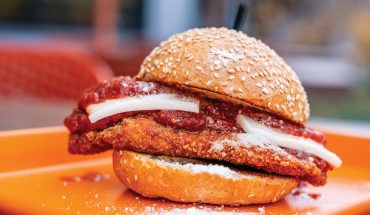by Kaitlyn Goalen
photographs by Jillian Clark
We live in an age in which craftsmanship is cool. “Small-batch” and “handmade” are buzzwords that indicate value and authenticity. This is especially true in the world of food, where the very idea suggests health, sustainability, and good taste.
Maple syrup is more closely associated with pancakes and lumberjacks than most other small-batch food products, but as far as I’m concerned, it’s one of the most artisanal, painstakingly crafted ingredients you can buy. To make true maple syrup, as opposed to the artificial maple-flavored corn syrups on the market, requires determination and optimism.
To begin with, the amount of source material required to create just a tiny amount of finished product is mind-boggling: It’s a ratio of about 40 to one. That’s 40 gallons of maple sap – collected painstakingly by tapping maple trees – to boil down for one gallon of grade-A maple syrup. It also takes great timing. Maple syrup production takes place during a brief, unpredictable window of a few weeks at the end of winter, when the temperature fluctuates just enough to cause the sap to flow.
Believe it or not, North Carolina has its own modest but delicious maple syrup production. Concentrated mostly in the western part of the state along the Blue Ridge mountain range, it’s one of the southernmost points in the country where the stuff is produced. And due to warmer temperatures, the ratios of production are even more outrageous, closer to 45 to one sap-to-syrup.
But the resulting product is worth it, light and delicate on the tongue. I found it to be far more versatile than some of the darker, deeper ambers of New England. Look for N.C. syrup to arrive in farmers markets in early March; you can order syrup from Waterfall Farm in Ashe County by phone.
Maple Butternut Squash Bread Pudding
Serves 8
This is one of those dishes that can (and should) be made the day before. I also love it because of its versatility: Serve it in the morning for a fancy brunch, or as a side next to roast chicken or pork tenderloin for dinner.
2 cups butternut squash, cut into 1-inch cubes
½ cup plus 1 tablespoon grade-A light maple syrup, divided (plus more for serving)
2 tablespoons olive oil
Salt and freshly-ground black pepper
1 pound sourdough bread, crusts removed
1 tablespoon unsalted butter
4 leeks, halved vertically and thinly sliced into half-moons
1 tablespoon fresh thyme leaves, chopped
4 ounces breakfast sausage
5 eggs
1 cup half-and-half
1 cup whole milk
1 cup chicken stock
1 cup grated sharp cheddar cheese, divided
Preheat the oven to 400 degrees. Butter a 13×9-inch baking dish.
In a medium bowl, toss the squash with the olive oil and 1 tablespoon of the maple syrup. Season generously with salt and pepper. Arrange the squash on a parchment-lined baking sheet and bake for 20 minutes, until caramelized in places and fork-tender. Set aside.
Lower the oven heat to 300 degrees. Cut the bread into 1-inch cubes and arrange on a baking sheet. Transfer to the oven and bake for 15 minutes, rotating once halfway through, until the bread is starting to get crispy. Let cool.
In a large skillet over medium heat, melt the butter. Add the leeks and cook, stirring, until they soften, about 5 minutes. Add the thyme and sausage and use the back of a wooden spoon to break it up into crumbles as it browns. When the sausage is well-browned, transfer the mixture to a paper-towel-lined plate. Let cool.
In a large bowl, whisk together the eggs, half-and-half, milk, chicken stock, ½ cup maple syrup, ½ teaspoon salt, and ½ teaspoon pepper. In another bowl, mix together the squash, bread, sausage, and ½ cup of the cheddar cheese. Transfer the bread mixture to the prepared baking dish and pour the egg mixture over the bread, pushing down with the back of a wooden spoon to make sure all the bread is submerged. Cover with foil and refrigerate overnight.
The next day, preheat the oven to 350 degrees. Pull the bread pudding from the refrigerator 30 minutes before you’re ready to bake. Remove the foil and top the surface of the pudding with the remaining cheese. Bake for 45 minutes, until the mixture has puffed up and doesn’t jiggle when moved. Serve with additional maple syrup, if preferred.





